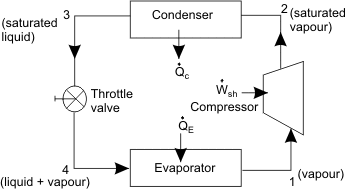Applications of Throttling
(a) Refrigeration
The working fluid (called refrigerant) leaving the evaporator as vapour at state 1 under goes an adiabatic compression in a compressor and leaves as saturated vapour at state 2. This compressed refrigerant enter a condenser where it rejects heat to the ambient atmosphere and leaves as a saturated liquid at high pressure at state 3. Then the liquid refrigerant at high pressure undergoes throttling and leaves as a state 3. Then the liquid refrigerant at high pressure undergoes throttling and leaves as a mixture of liquid and vapour at low pressure at state 4. During throttling, the liquid vaporizes partially and its temperature decrease. The cooled refrigerant then passes through an evaporator where it absorbs energy from the body to be cooled, and leaves as hot vapor at state 1. Finally, the hot refrigerant vapour goes to the compressor, thus completing a cycle.

Figure 14.5 Applying the first law of thermodynamics to each of the units (control volume) the following relations are obtained:
Compressor (adiabatic) 
Condenser (constant pressure cooling) 
Throttling (isenthalpic) 
Evaporator (constant pressure heat addition) 
The coefficient of performance (COP) of the refrigerant is defined as the ratio of the energy absorbed at the evaporator to the energy required to perform the task.
|